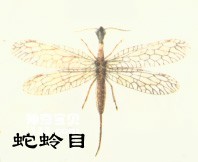[Economic Significance] The gnat insect is named after its snake-like shape. Adults can be found in flowers, leaves, tree trunks, etc., feeding on aphids, lepidopteran larvae, etc. The larvae can be found under the loose bark of trees, especially coniferous trees, and prey on other small soft-bodied insects. Therefore, they are a class of natural enemy insects.

[Identification Points] The head is elongated and the rear is contracted into a triangle, which is a hypostomia (the mouthparts are downward, that is, the longitudinal axis of the head and the longitudinal axis of the body are roughly at right angles. This type of head is called a hypostomia). Chewing mouthparts. The tentacles are long and filamentous. The forechest is as long and slender as the neck, and the front feet are located at the back end of the forechest. The two pairs of wings are identical, with one wing nevus. The female has an elongated ovipositor.
The characteristics of this order can be summarized as follows: the cephalothorax is elongated, and the four wings are transparent and black; the female has a needle-like ovipositor, and the larvae catch small beetles on the tree trunk.
[Species and Distribution] About 100 species are known in the world, mainly distributed in temperate areas except Australia. This order only includes two families. Those with single eyes and transverse veins in the wing nevus are called Raphidiidae; those with no single eye on the head and no transverse veins in the wing nevus are called Inocelliidae.
animal tags: Ophiophores
We created this article in conjunction with AI technology, then made sure it was fact-checked and edited by a Animals Top editor.